I saw an analyst report from a bank that estimated what the primary silver producers would generate in free cash flow this year.
It wasn’t pretty.
However, it carries a direct hint about where the price of silver is headed.
While it doesn’t mean a surge in the silver price is imminent, the industry has been here before and demonstrated there’s only one way out of this dilemma.
First, let’s set the stage…
What TINY Looks Like
I think most of this audience knows the silver market is small.
At a $20 silver price, estimated supply this year is worth roughly $20 billion.
As I write, the market cap of Starbucks is $112 billion. Good coffee, but is a company that makes lattes really worth 5½ times more than the entire 2022 supply of a critical strategic metal?
The primary silver equity market is also small. By “primary” we mean those producers whose primary metal is silver. Roughly 75% of silver comes from non-silver mines, so there’s only a handful of true primary silver producers.
And those handful of producers have a tiny market cap compared to other resource markets.

As of November 7, the market cap for the diversified miners (BHP, Rio Tinto, etc.) is $441.3 billion. Gold is $225.7 billion, while copper is $118.2 billion.
The market cap of the entire primary silver producers is just $21.9 billion.
Compare silver’s $21.9B market cap to Apple’s CASH level of $179 billion. Apple could buy the entire primary producer sector and still have $157.1 billion left.
Heck, the market cap for the demand of silver metal in 2009 was $35.1 billion!
The primary silver equities market is puny because investors have been discouraged by both silver prices and stock prices and sold, pushing the market cap lower. In turn this has hurt the companies, both production and growth.
This fact sets the stage for…
How Long Can You Be in the Red?
The analyst report I mentioned estimated what the primary silver producers would earn in free cash flow on a net basis for 2022. The report was done in early November, so it is up to date.
It’s very sobering for this niche industry. You experienced investors can probably guess what it shows.

On a net basis, most primary silver producers are unable to generate positive free cash flow.
And the #1 reason they can’t do so is because of the depressed silver price.
This is a hint for the silver price, because obviously a sector can’t remain unprofitable indefinitely.
So, what’s the answer?
There’s Only One Way Out
Higher silver prices, that’s it.
It’s really true, because miners have already lowered costs about as much as they can. The persistent low silver price has forced them to do so…
- The average All-In Sustaining Cost (AISC) of the producers is currently $19.33 per ounce (on a weighted basis). The silver price was in the low $20s through June of this year—but since then has averaged just $19.55, barely above the industry’s average production cost.
Getting the industry average meaningfully lower is almost impossible, especially when we now have high inflation, which of course impacts the mining sector like everyone else. There are exceptions, but generally costs are rising. The silver price has to eventually rise to account for this.
- Further, a number of miners have performed high grading, a practice where they mine the higher-grade portions of their deposits, in an effort to generate better revenue. They can’t do this forever either, and for those that have relied on it, a harsh reality is dead ahead: the low grade portions of their deposits may not be feasible if the silver price remains low, because the low grade only works if the high grade material is available to mix with it.
The same research showed there is likely to be some improvement across the sector in 2023, but they estimate over half still won’t generate positive free cash flow. Even at slightly higher silver prices.
- This again highlights that the silver price must be higher in order for the industry to operate profitably. (By the way, this is NOT a list of recommendations. The ones to consider are those expected to have the biggest turnaround in generating free cash flow—the bank report and I agree on this one).
It’s true that three out of four ounces come from non-primary silver mines. They don’t require a high silver price; the silver is a byproduct and only offsets their total production costs. But it can naturally cause profitability problems. And they probably didn’t expect silver to average $19.55 an ounce during high inflation. So these producers too are hoping for (and in a few cases, need) a higher silver price.
If low silver prices were to persist, it could put some companies out of business, force some to cut back to only their highest-grade mines, push some to merge, or other things they may not necessarily want to do.
It can affect the industry in other ways, too: exploration and development budgets could fall, top management people including geologists could leave the industry, and students could be discouraged from choosing mining as a profession. It can turn into an ugly vicious cycle.
However, I don’t expect these extreme things to happen. All it takes is a higher silver price and the difficulties start to ease up for most of them.
Ultimately, the silver price MUST go higher. The industry can’t function this way indefinitely. Persistent high inflation demands it, too.
The miners are hinting that an upward shift in silver’s price is coming.
I recommend we invest accordingly.



